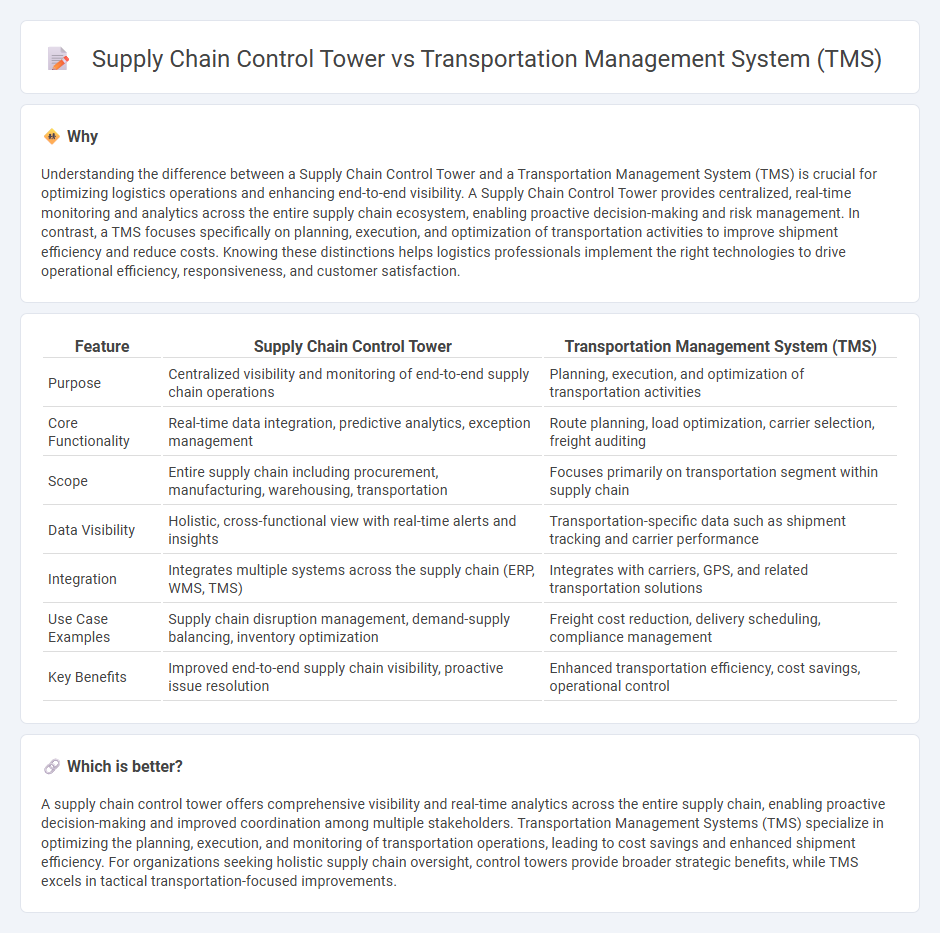
Supply chain control towers provide end-to-end visibility and real-time analytics across multiple logistics functions, enabling proactive decision-making and risk mitigation. Transportation Management Systems (TMS) focus primarily on optimizing transportation operations, such as route planning, carrier selection, and freight auditing, to improve shipment efficiency and cost management. Discover how integrating supply chain control towers with TMS can transform logistics performance and operational agility.
Why it is important
Understanding the difference between a Supply Chain Control Tower and a Transportation Management System (TMS) is crucial for optimizing logistics operations and enhancing end-to-end visibility. A Supply Chain Control Tower provides centralized, real-time monitoring and analytics across the entire supply chain ecosystem, enabling proactive decision-making and risk management. In contrast, a TMS focuses specifically on planning, execution, and optimization of transportation activities to improve shipment efficiency and reduce costs. Knowing these distinctions helps logistics professionals implement the right technologies to drive operational efficiency, responsiveness, and customer satisfaction.
Comparison Table
| Feature | Supply Chain Control Tower | Transportation Management System (TMS) |
|---|---|---|
| Purpose | Centralized visibility and monitoring of end-to-end supply chain operations | Planning, execution, and optimization of transportation activities |
| Core Functionality | Real-time data integration, predictive analytics, exception management | Route planning, load optimization, carrier selection, freight auditing |
| Scope | Entire supply chain including procurement, manufacturing, warehousing, transportation | Focuses primarily on transportation segment within supply chain |
| Data Visibility | Holistic, cross-functional view with real-time alerts and insights | Transportation-specific data such as shipment tracking and carrier performance |
| Integration | Integrates multiple systems across the supply chain (ERP, WMS, TMS) | Integrates with carriers, GPS, and related transportation solutions |
| Use Case Examples | Supply chain disruption management, demand-supply balancing, inventory optimization | Freight cost reduction, delivery scheduling, compliance management |
| Key Benefits | Improved end-to-end supply chain visibility, proactive issue resolution | Enhanced transportation efficiency, cost savings, operational control |
Which is better?
A supply chain control tower offers comprehensive visibility and real-time analytics across the entire supply chain, enabling proactive decision-making and improved coordination among multiple stakeholders. Transportation Management Systems (TMS) specialize in optimizing the planning, execution, and monitoring of transportation operations, leading to cost savings and enhanced shipment efficiency. For organizations seeking holistic supply chain oversight, control towers provide broader strategic benefits, while TMS excels in tactical transportation-focused improvements.
Connection
Supply chain control towers and transportation management systems (TMS) are interconnected through real-time data integration, enabling end-to-end visibility and enhanced decision-making in logistics operations. The control tower aggregates data from the TMS to monitor shipment status, optimize routing, and manage disruptions proactively. Leveraging advanced analytics, this connection improves freight cost efficiency and delivery performance across the supply chain network.
Key Terms
**Transportation Management System (TMS):**
Transportation Management Systems (TMS) optimize the planning, execution, and tracking of freight movements, enhancing route efficiency, carrier selection, and cost management within logistics operations. With real-time visibility, automated dispatch, and performance analytics, TMS improves delivery accuracy and reduces transportation expenses. Explore how TMS can transform your logistics strategy and streamline supply chain execution.
Route Optimization
A transportation management system (TMS) specializes in route optimization by leveraging algorithms that analyze factors such as traffic patterns, delivery windows, and fuel consumption to create the most efficient shipment paths. Supply chain control towers provide a broader real-time visibility platform that integrates route optimization with end-to-end supply chain monitoring, enabling proactive decision-making across multiple logistics functions. Explore in-depth comparisons to understand how each system enhances route optimization and overall supply chain efficiency.
Freight Settlement
A Transportation Management System (TMS) automates freight settlement by streamlining carrier invoice auditing, payment processing, and freight cost allocation to optimize transportation spend. In contrast, a Supply Chain Control Tower offers real-time visibility across the entire supply chain, enabling proactive freight settlement adjustments based on dynamic shipment data and exceptions. Explore how integrating both solutions can enhance accuracy and efficiency in freight settlement operations.
Source and External Links
What is a Transportation Management System (TMS)? | Manhattan - A TMS is a supply chain software solution that enables enterprise-wide management, optimization, planning, and execution of logistics services for transporting goods, improving route optimization, real-time visibility, fleet coordination, automation, and planning to increase profitability and customer satisfaction.
Transportation management system - Wikipedia - A TMS is a subset of supply chain management focused on transportation operations, serving as an intermediary between ERP/order processing and warehouse/distribution, offering routing solutions, carrier selection, shipment execution, and freight audit/payment, with various licensing models including SaaS and on-premises options.
What is a transportation management system (TMS)? - IBM - A TMS is a real-time logistics tool, often cloud-based and integrated with ERP/SCM systems, that streamlines inbound/outbound shipping, enhances shipment tracking and automation, and uses AI/ML to optimize transportation processes for better supply chain collaboration and performance visibility.
 dowidth.com
dowidth.com